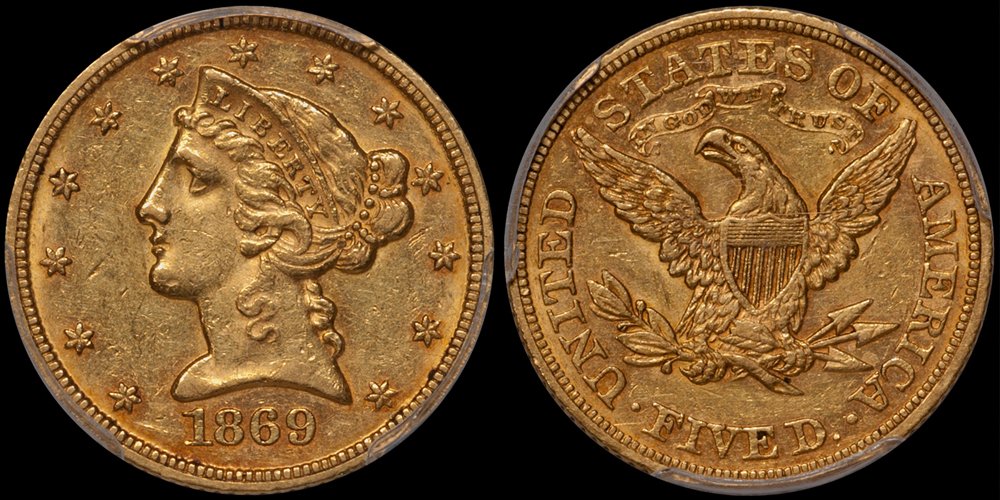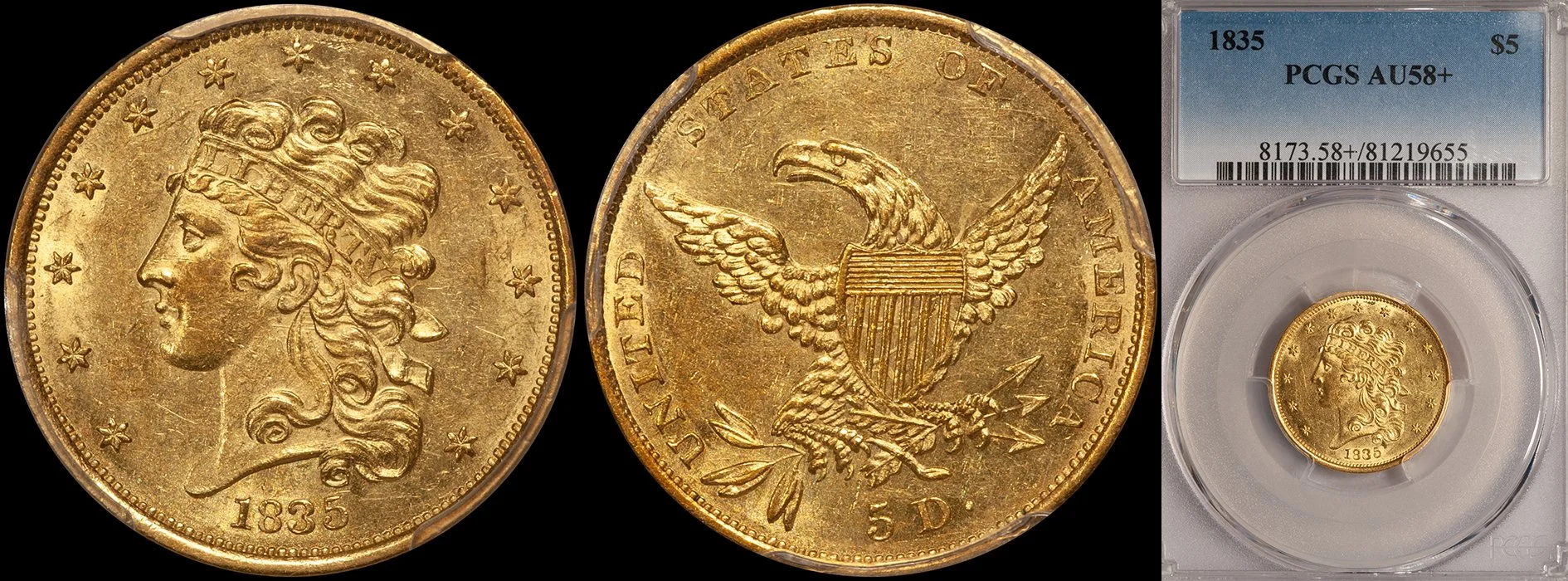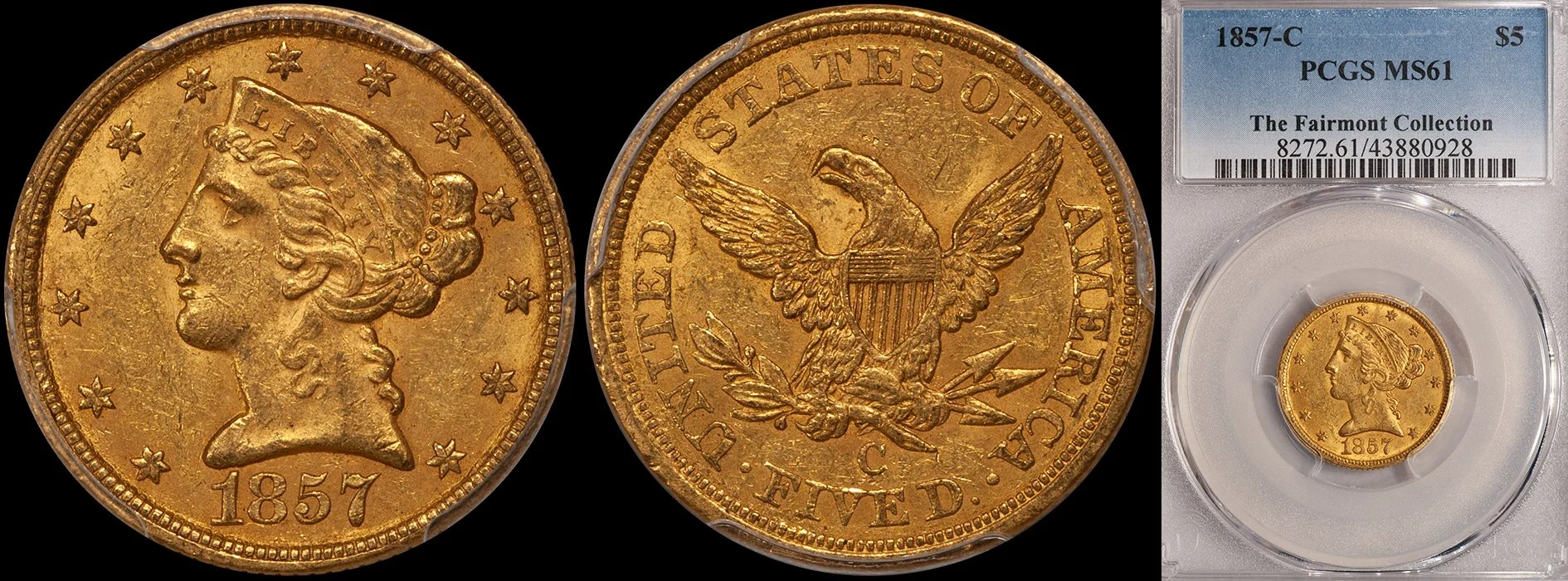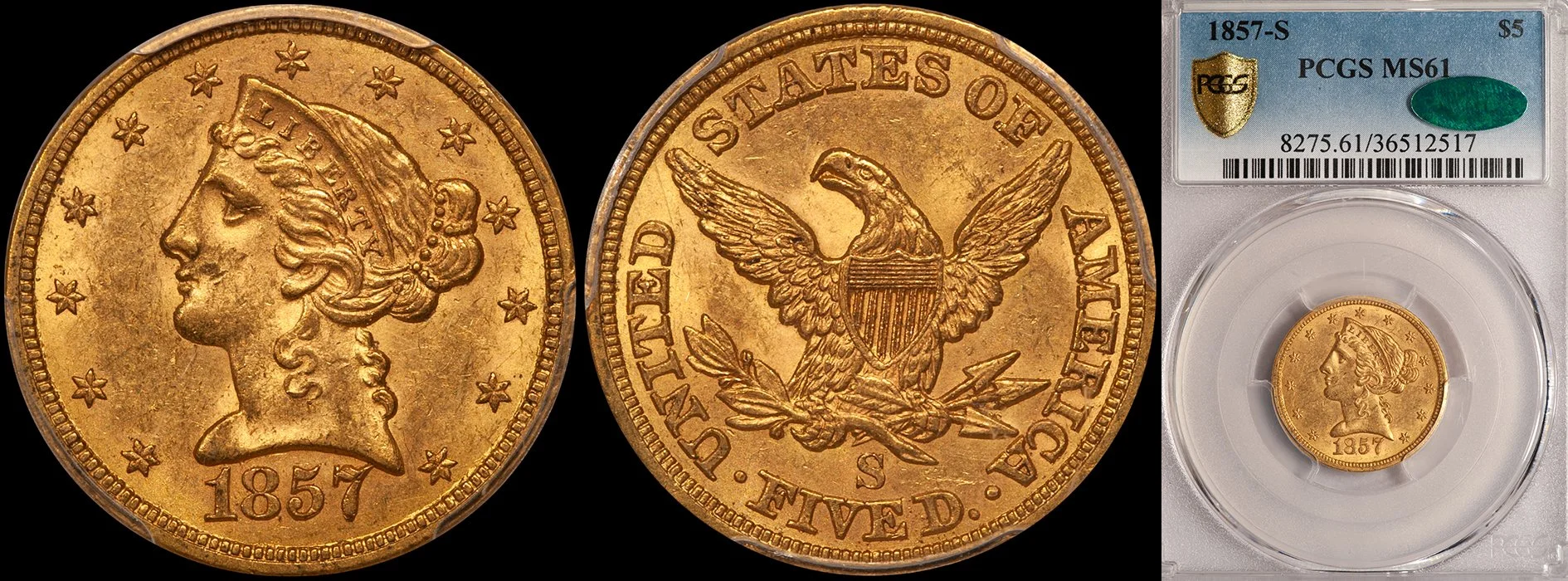A Dozen Undervalued Liberty Head Half Eagles
/Viewed as a whole, the long-lived Liberty Head half eagle series contains more “undervalued” issues than perhaps any other American gold coin type. Struck from 1839 through 1907 and produced at no less than seven mints, this series contains coins ranging from ultra-rare (the 1854-S with just three known) to ultra-common.
When I refer to a specific issue as being “undervalued” it is within the context of the series. Some of the coins I list below are fairly expensive but they are nearly impossible to locate with choice, original surfaces and natural color.
Thousands of nice No Motto and With Motto Liberty Head half eagles have come into the market since 2018. These have been marketed by Stack’s Bowers as the Fairmont Hoard and for the most part, these coins are wonderful in appearance with the nice “crusty” appearance I love but without the so-called “vault dirt” caked onto the surfaces (which leaves a blackish hue) which many collectors don’t care for. Some formerly scarce issues have become more available (the 1868 through 1874 San Francisco issues come to mind), but many others have been almost entirely unaffected by this exceptional hoard.
It was hard to limit this list to just a dozen coins. I could easily have added at least a ten more; maybe even another twelve on top of this. If I get enough motivational feedback, I’ll crank out another article featuring the Next Dozen.
1. 1840-O
This first-year-of-issue is far more available than its counterparts the 1840-C and the 1840-D. That said, the 1840-O is extremely underpriced in relation to those two dates. In my experience, choice original examples of the 1840-O are exceptionally hard to find and I’ve only handled one nice Uncirculated piece (Heritage 4/2020: 3795 which I bought for $19,200 and sold to a Florida collector) in well over a decade.
1840-O $5.00 PCGS AU58 CAC
You can still buy an AU55 to AU58 for less than $5,000 and I think this is way too cheap for a coin which is scarce (ignore the NGC population as it is absurdly inflated) and numismatically significant.
I also need to include the 1840-O Broad Mill. Unfortunately, PCGS doesn’t include this variety (NGC does) and this relegates it to obscurity. It is the single rarest of all the New Orleans half eagles and it is unique in Uncirculated. I can’t think of a more undervalued half eagle of any type than this!
2. 1841
The Fairmont Hoard contained next to no examples of the 1841 half eagle (the only one to have sold so far at auction was a PCGS/CAC AU53 which brought $3,120 as Stack’s Bowers 8/2020: 1342), so it doesn’t seem likely that this undervalued date will have its status changed any time soon.
1841 $5.00 PCGS EF40 CAC, ex Fairmont
The 1841 remains relatively inexpensive in EF and the lower AU grades with nice coins still available in the $1,500-3,000 range. Interestingly, it is almost harder to find a solid AU55 example than it is a nice Uncirculated. This is due to a small hoard of approximately six to nine coins, mostly in MS63 to MS64, which entered the market sometime before I did (and I date back to the very early 1980s).
I have been putting together a personal set of nice AU No Motto half eagles from Philadelphia as it is a fun challenge (plus the Fairmont Hoard coins from this era were so nice that I was motivated to start a collection due to their availability). The 1841 is a date that I still have been unable to locate and this project has been going on since 2018.
3. 1842 Large and Small Letters
If you are a long-time reader of my articles and blogs on US gold you are no doubt aware of my infatuation with both of these varieties.
1842 Large Letters $5.00 PCGS AU50
The Large Letters is the scarcer of the two by a fairly considerable margin. There are as few as 50-60 known with most in the EF40 to AU50 range. Nice AU coins are extremely scarce yet they are still priced in the $5,000-10,000 range. This isn’t inexpensive given the fact that P mint half eagles are still not actively collected by date but (and I realize this is an apples to oranges comparison) if this were a Charlotte or Dahlonega half eagle with this degree of rarity, an AU55 would be worth at least twice what the 1842 Large Letters is currently valued at.
The Small Letters is considerably less scarce in terms of overall availability but it still is no slouch. Virtually all the known examples grade lower than AU53 and a properly graded AU55 or better is extremely rare. Heritage 10/2020: 18373 was graded AU58 by PCGS and approved by CAC, and it sold for $8,400 which, in retrospect, was extremely good value. In Uncirculated, this variety is extremely rare.
4. 1842-D Large Date
When collectors discuss rare half eagles from Dahlonega, they inevitably mention the 1838-D, 1839-D, and the 1861-D. These issues are numismatically significant but they pale in overall and high grade rarity next to the 1842-D Large Date. This is easily the rarest half eagle from this mint in terms of both overall and high grade rarity.
1842-D Large Date $5.00 PCGS AU55 CAC
But where the 1842-D Large Date really shines is in what I call appearance rarity. CAC allows us to quantify how difficult it is to locate a high end coin as the majority of the coins approved by this service are better than average for the date and grade. CAC has approved just seven examples of this issue with three grading lower than EF40, none in either of the two Extremely Fine grades, and four in About Uncirculated with the single best an AU58.
Despite its obvious rarity, the 1842-D Large Date is clearly undervalued. I’ve always attributed this to the fact that the 1842-D Small Date is thought of as a “substitute” and it is far more available.
Since the beginning of 2010, just two PCGS AU examples of this variety have appeared at auction and both were very low-end coins graded 50. I seriously doubt if as many as five or six nice 1842-D Large Date half eagles exist in all grades combined, and the sole example from the Fairmont hoard is a cleaned piece with AU details.
5. 1847-O
You’re probably wondering what the single rarest New Orleans half eagle is doing on this list. After all, it’s a fairly pricey date and its rarity is well-known. What most collectors don’t realize is just how incredibly rare the 1847-O half eagle is with natural color and choice surfaces. It has been years since I’ve seen one which I thought was nice (not including the finest known and unique in Uncirculated PCGS/CAC MS61 I bought and sold in late 2018).
1847-O $5.00 PCGS AU53
I doubt if there are more than three or four truly nice collector grade 1847-O half eagles known and there are likely not more than two or three AU coins which I genuinely liked. Want verification? CAC has approved four in EF, just one in AU (53) and the aforementioned MS61.
If a nice PCGS/CAC EF45 came up for sale, it might bring $12,500 and I would consider such a coin to be exceptional value given its rarity. It is important to consider that the 1847-O is the key issue in a fairly popular series. But it should also be noted that if this were a Charlotte or Dahlonega half eagle with this rarity profile, it would be at least double—if not triple—the price of the 1847-O.
It is also interesting to note that this date was unrepresented in the Fairmont half eagles. In other words, there wasn’t a single 1847-O in the thousands of half eagles in this mammoth offering.
6. 1849
In grades up through AU55, the 1849 half eagles is a fairly common issue. There were numerous pieces in the Fairmont holdings and the current trading level of $1,250-1,750 for a nice AU, this represents good value. The best value for this date, in my opinion are PCGS/CAC AU58s which are currently worth around $2,500-3,000, and nice MS61 coins which currently cost around $5,000. Given their low populations, I could see nice PCGS/CAC 1849 half eagles in these grades doubling in the coming years.
1849 $5.00 PCGS MS61
In January 2021, Heritage sold what may likely be the current finest known 1849 half eagle: a PCGS/CAC MS63 which brought $21,600. This is a population 1/0 coin which is also a very neat repunched date variety. In my opinion, this was among the better values in the No Motto half eagle market in the last year
7. 1854-C
In my opinion, this date is one of the two most undervalued Liberty Head half eagles from this mint, along with the 1861-C.
1854-C $5.00 PCGS AU53 CAC
There is a fairly unique set of circumstances which makes the 1854-C an appearance rarity. An unusually high percentage has been stripped and this is an extremely difficult issue to locate with natural surfaces and nice color. This is compounded by the fact that most of the nicer 1854-C half eagles show a weak mintmark which, in my opinion, is far less desirable than examples with a strong mintmark.
I find it very interesting that there have been a number of 1854-C half eagles in the Fairmont holdings; mostly in the EF45 to AU53 range and mostly with weak mintmarks. Some of these weak mintmark coins have still sold for really strong prices (Stack’s Bowers 11/2021: 3276 graded PCGS/CAC EF45 at $5,280 and Stack’s Bowers 8/2021: 606, also graded EF45 by PCGS/CAC, at $5,760) and these are not much different than Heritage 11/2021: 3337—a PCGS/CAC AU50 with a strong mintmark—at $6,600.
8. 1859
I’m fond of all the Philadelphia half eagles produced from 1858 through 1861, but I feel that the 1859 is the most underrated of these.
1859 $5.00 PCGS EF45 cAC
There are not a ton of these available in the EF40 to AU53 range and for $2,500 or so, the savvy collector can acquire a nice AU50 to AU53 coin. Prices for AU55 and AU58 1859s have basically doubled since a small number were sold as part of the Fairmont Hoard. Not a single Uncirculated 1859 half eagle was present in the Fairmont holdings and the last example to sell at auction realized $21,150 in 2015.
The finest known 1859 half eagle, graded PCGS/CAC MS64+, was located in Pennsylvania a few years ago and it was subsequently sold to collector DL Hansen for a sum reported to be around $60,000.
9. 1869
I’m also fond of the Reconstruction Era Philadelphia half eagles, especially the 1869-1872 dates. I’m going to go with the 1869 here, but I could just as easily have focused on the other issues.
1869 $5.00 PCGS AU58 CAC
The mintage of this date is a paltry 1,760 business strikes. There are an estimated 50-60 known. When available, this date tends to come in grades in the EF45 to AU50 range and virtually every piece I have seen is prooflike, very heavily abraded, and completely stripped due to dipping or more drastic surface alterations. I sold the only 1869 half eagle to have been approved by CAC (a nice PCGS AU58) until the upcoming Fairmount AU53. There is a single Uncirculated piece known. It is graded MS64 by NGC and it was last sold in 2003 for $28,750.
The most recent APR for a PCGS AU55 is Heritage 4/2020: 4442 which brought $7,800. I recently sold a PCGS AU58 on my website for $10,250, which seems like excellent value for a low mintage date with a current PCGS population of five in this grade with none finer.
10. 1875-S
The 1870s San Francisco half eagles aren’t especially popular with collectors, although the low mintage 1876-S has received a reasonable amount of acclaim over the last few years.
1875-S $5.00 PCGS AU55
While not as rare as the 1876-S, the 1875-S is a scarce issue and it remains affordable in collector grades. A nice EF example should be available at around $3,000 while an AU55—if available—will cost around 6,000.
Where this date really shines, though, is in high grades. The 1875-S is unique in Uncirculated with the sole piece currently known being the James Stack/Bass coin graded MS64 by PCGS. I’m sure that this coin would bring a price approaching six figures. But if a lower graded Uncirculated coin became available—say a PCGS MS62—I’m not sure it would sell for much more than $30,000-40,000.
11. 1889 and 1890
1889 $5.00 PCGS MS63+ CAC
I’m including these two dates as a tandem entry because they are quite similar in a number of respects.
The 1889 has a mintage of 7,520 business strikes. It is almost never seen in grades lower than AU50, with the typical example in the AU55 to MS62 range and characterized by excessively abraded and noticeably dipped-out surfaces. There are just five MS63s at PCGS with two finer in MS63+, and an incredible outlier PCGS/CAC MS67 which brought a strong $40,250 when it last sold in June 2008. You can likely buy one of the MS63s for around $5,000, and with just a single piece currently approved by CAC, we’ll assume your coin won’t sticker.
The 1890 has an even lower mintage with 4,240 made for circulation. You’ll have no trouble finding an AU55 to AU58 (although a CAC approved piece will offer somewhat of a challenge), but an Uncirculated piece will be a bit trickier and every coin you try to buy will be extensively bagmarked. PCGS has graded a dozen in MS62 but only two in MS63, one each in MS64 and MS64+, plus a single MS67. NGC has graded one coin MS68★, and this amazing coin brought $54,050 when it last sold in 2017.
Both of these coins have had their AU and low MS population numbers basically doubled by the Fairmont holdings, but I have it on very good information that there are no more 1889 or 1890 half eagles in grades higher than MS62, and likely just a very small number even as high as MS61.
12. 1892-O
This is an issue which I’ve championed for over two decades and I still feel it is undervalued.
What makes it an interesting issue is that its rarity profile is almost exactly inverse to most of the No Motto issues from New Orleans which have around 90-95% of the total known in all grades skewed towards well-circulated and lightly circulated grades. Most of the 1892-O half eagles which exist saw little—if any—circulation and even the ones in AU55 and AU58 holders have bag friction/excessive handling marks as opposed to actual wear.
1892-O $5.00 PCGS MS63 CAC
I’ve only handled one 1892-O in MS63 or finer (a PCGS/CAC MS63 which I placed in the New England Collection in 2019) and even the supply of blah-quality MS60 and MS61 pieces have dried up.
If this issue were a No Motto Liberty Head half eagle it would gain more notoriety and its price would immediately increase by 50%.
It should be noted that while a few 1892-O half eagles were in the Fairmont holdings, there were none finer than MS60.
There you have it: my list of a dozen+ of the most underrated dates in the Liberty Half Eagle series. I could easily come up with a dozen more, and would be interested to hear your opinions of which coins in this series represent especially good value. You can use the Comments section below to do this.
Douglas Winter is a leading market maker in all U.S. gold coins including rare half eagles such as the ones listed above. Send Doug an email at dwn@ont.com to discuss buying and selling of these issues.

























